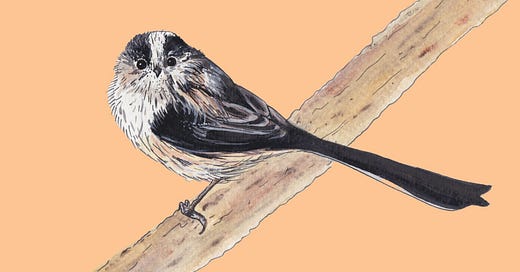A few weeks ago, my friend sent me a photo from ‘Kent Birding’ group featuring a pretty bird perched on a blackberry bush in a nature reserve we’d visited a week or so before. “Dis beauty… do you know what it is?”
I’m always pleased when I get these questions from friends and actually know the answer immediately, without having to do any research! In this case, the beauty in question was one of my favourite common but head-turning birds: the long-tailed tit!
You’ll have to forgive me, as you’ve had most of the following content in a Nature Notice Board email, tucked in after some facts about blue tits and great tits, but I thought long tails deserved a post of their own!
Long-Tailed Tit (Aegithalos caudatus)
Long-tailed tits are easily recognisable because (you guessed it!) they have a very long tail, which is actually longer than their bodies. Adults have distinctive badger-like facial markings and young birds look like they’re wearing a black bandit mask.
Long-tailed tits have an undulating flight (similar to woodpeckers and several other birds) and you’ll usually spot them in busy flocks of up to about 20 birds, flitting about in the trees.
I always think long-tailed tits look almost cartoonish and wouldn’t be out of place in a Disney film. In fact, how has there not been a long-tailed tit animation by now? The birds huddle together with many others to keep warm on winter nights and they build the softest looking nests which are like egg-shaped sleeping bags made from moss. Parents-to-be line their nests with up to 1,500 feathers to make them as soft and cosy as possible for their eggs and camouflage breeding sites with cobwebs and lichen. What brilliant parents!
Did you know?
Just when you thought you couldn’t love long-tailed tits any more, you discover they are also ‘cooperative breeders’. Individual pairs try to rear their own young, but if they fail, they’ll help close relatives out at their nests instead. Only eight percent of bird species are thought to do this!
Open your ears
My best tip for spotting long-tailed tits is to get to know their call, as I nearly always hear them before I see them - they’re very vocal little birds. Long-tailed tits make regular contact calls that sound a bit like a high pitched whistle, as well as more subtle rattly-sounding calls.
has a great post about long-tailed tits and the lovely sounds they make…If you’re going on an autumnal walk this weekend, woodland is always a good place to look for long-tailed tits, but they can just as well be found in parks, farmland and even in gardens, as long as there are several trees around. Where I live, I mostly see them in trees along the river. I’d love to know if you spot (or hear) long-tailed tits when you’re out and about, so please comment if you come across any on your travels.
Sources and Further Reading:
Wildlife Trusts Profile: Long-Tailed Tit
RSPB Profile: Long-Tailed Tit
Birdsong Academy’s Shriek of The Week: Long-Tailed Tit
You Might Also Like…
Make your home a destination for birds
This is part of a series of guest posts being published throughout June. Find out more about Katie Reed of Outdoor Answer, who wrote this article, at the end of this post.








We call them lollipop birds. They are great to show non birdy people as they are so cute and relatively easy to see once you’ve heard them. We get flocks passing through with other tits, chiff chaffs & goldcrests mixed in. There are birch trees level with upstairs windows which they love. Such a treat to see them. Only downside is as you age you can’t hear the call any more 🙁 find it sad walking with my mum (who’s 81) when she can’t hear them…
Oh I love long-tailed tits! They are one of the first birds we really fell in love with when we first started actively birdwatching!! The way they flit around in their little flocks always looks so pretty!